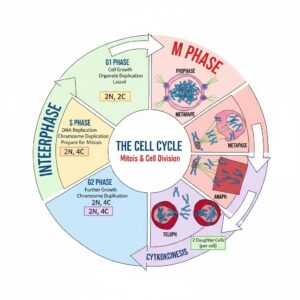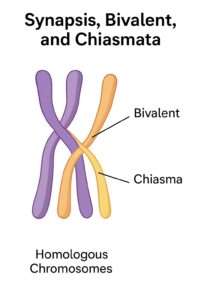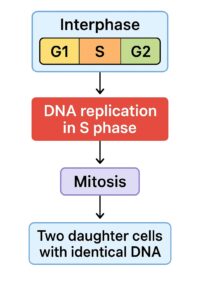1st PUC Biology Question and Answer: CELL CYCLE AND CELL DIVISION
Looking for 1st PUC Biology textbook answers? You can download Chapter 10: CELL CYCLE AND CELL DIVISION Questions and Answers PDF, Notes, and Summary here. 1st PUC Biology solutions follow the Karnataka State Board Syllabus, making it easier for students to revise and score higher in exams.
Karnataka 1st PUC Biology Textbook Answers—Reflections Chapter 10
CELL CYCLE AND CELL DIVISION Questions and Answers, Notes, and Summary
1st PUC Biology Chapter 10
CELL CYCLE AND CELL DIVISION

Scroll Down to Download CELL CYCLE AND CELL DIVISION PDF
Question and Answer:
Question 1.
What is the average cell cycle span for a mammalian cell?
Answer:
The average cell cycle span for a mammalian cell is approximately 24 hours.
Question 2.
Distinguish cytokinesis from karyokinesis.
Answer:
- Karyokinesis: It is the phase in which the nucleus divides into two daughter nuclei. The separation of daughter chromosomes takes place during this phase. It consists of four substages — prophase, metaphase, anaphase, and telophase.
- Cytokinesis: It refers to the division of the cytoplasm that follows karyokinesis, resulting in the formation of two daughter cells.
Question 3.
Describe the events taking place during interphase.
Answer:
Interphase is the phase between two successive cell divisions during which the cell prepares for the next division. It is divided into three stages — G₁ phase, S phase, and G₂ phase.
- G₁ Phase (Gap 1):
- The cell is metabolically active and grows continuously.
- It carries out normal cellular functions but does not replicate DNA during this stage.
- S Phase (Synthesis Phase):
- DNA replication or synthesis occurs, and the amount of DNA per cell doubles (from 2C to 4C).
- However, the number of chromosomes remains the same.
- Centriole duplication also takes place in animal cells.
- G₂ Phase (Gap 2):
- The cell continues to grow and synthesises proteins necessary for mitosis.
- The cell is now fully prepared to enter the M phase (mitosis).
Thus, during interphase, the cell grows, duplicates its DNA, and prepares all the components required for cell division.
Question 4.
What is G (quiescent phase) of cell cycle?
Answer:
Some cells in adult animals that divide only occasionally to replace lost or damaged cells exit the G₁ phase and enter an inactive stage called the quiescent stage (G₀) of the cell cycle. Cells in this stage remain metabolically active but no longer proliferate unless they are called upon to do so by the organism.
Question 5.
Why is mitosis called equational division?
Answer:
Mitosis is called equational division because it maintains the chromosome number and genetic stability in the daughter cells. The daughter cells formed after mitosis have the same number and type of chromosomes as the parent cell.
Question 6.
Name the stage of cell cycle at which one of the following events occur:
(i) Chromosomes are moved to spindle equator.
(ii) Centromere splits and chromatids separate.
(iii) Pairing between homologous chromosomes takes place.
(iv) Crossing over between homologous chromosomes takes place.
Answer:
(i) Metaphase
(ii) Anaphase
(iii) Zygotene stage of Prophase I (Meiosis I)
(iv) Pachytene stage of Prophase I (Meiosis I)
Question 7.
Describe the following:
(a) synapsis
(b) bivalent
(c) chiasmata
Draw a diagram to illustrate your answer.
Answer:

- Synapsis: During the zygotene stage of prophase I in meiosis, homologous chromosomes start pairing together, and this process of association is called synapsis.
- Bivalent: The synaptonemal complex formed by a pair of synapsed homologous chromosomes is called a bivalent or tetrad.
- Chiasmata: At the diplotene stage, the synaptonemal complex dissolves, and the homologous chromosomes tend to separate except at the sites of crossing over. These X-shaped structures are called chiasmata. In some vertebrates, diplotene can last for months or years.
Question 8.
How does cytokinesis in plant cells differ from that in animal cells?
Answer:
Due to the presence of a cell wall, cytokinesis in a plant cell is significantly different from that in animal cells. Instead of forming a contractile ring, plant cells construct a cell plate in the middle of the cell. The Golgi apparatus releases vesicles containing cell wall materials, which fuse at the equatorial plane to form a cell plate. This cell plate later develops into the middle lamella between the walls of two adjacent daughter cells.
Question 9.
Find examples where the four daughter cells from meiosis are equal in size and where they are found unequal in size.
Answer:
At the end of meiosis II (telophase II), the four daughter haploid cells may or may not be equal in size.
- In spermatogenesis (formation of sperms in males), the four daughter cells are equal in size.
- In oogenesis (formation of ovum in females), the four daughter cells are unequal in size — producing one large ovum and three small polar bodies.
Question 10.
Distinguish anaphase of mitosis from anaphase I of meiosis.
Answer:
Anaphase of Mitosis | Anaphase I of Meiosis |
(a) Centromeres split at this stage, and sister chromatids separate to move toward opposite poles. | (a) Centromeres do not divide at this stage. Homologous chromosomes separate, while sister chromatids remain associated at their centromeres. |
(b) The chromosomes are long and thin. | (b) The chromosomes are shorter and thicker. |
Question 11.
List the main differences between mitosis and meiosis.
Answer:
Feature | Mitosis | Meiosis |
1. Number of divisions | Involves one cell division. | Involves two successive cell divisions. |
2. Number of daughter cells | Produces two daughter cells. | Produces four daughter cells. |
3. Chromosome number | Daughter cells have the same chromosome number as the parent cell (diploid → diploid). | Daughter cells have half the chromosome number of the parent cell (diploid → haploid). |
4. Type of cells produced | Produces somatic (body) cells. | Produces gametes (sex cells). |
5. Genetic composition | Daughter cells are genetically identical to the parent cell. | Daughter cells are genetically different due to crossing over and independent assortment. |
6. Occurrence of synapsis and crossing over | Absent. | Present during Prophase I. |
7. Function | Helps in growth, repair, and asexual reproduction. | Helps in formation of gametes and maintenance of chromosome number across generations. |
Question 12.
What is the significance of meiosis?
Answer:
The significance of meiosis is as follows:
- It reduces the number of chromosomes to half in the daughter cells.
- It is an essential process in the life cycle of sexually reproducing organisms, as it restores the fixed number of chromosomes present in the somatic cells, characteristic of the species.
- Gametes are formed as a result of meiosis, and each gamete possesses half the number of chromosomes present in somatic cells.
- It prevents the multiplication of chromosomes, thereby maintaining the stability and constancy of the chromosome number in a species.
- During crossing over, the exchange of genetic material (genes) leads to genetic variation within the species, resulting in new combinations of hereditary traits.
Question 13.
Discuss with your teacher about
(1) haploid insects and lower plants where cell-division occurs, and
(ii) some haploid cells in higher plants where cell-division does not occur.
Answer:
- Haploid insect – Honey bee
haploid lower plants – Spirogyra, Riccia. - Male and female gametes.
Question 14.
Can there be mitosis without DNA replication in ‘S’ phase?
Answer:
No, mitosis cannot occur without DNA replication. DNA replication in the S phase of interphase ensures that each daughter cell receives an identical set of chromosomes. Without DNA replication, the daughter cells would have incomplete or half the genetic material, leading to genomic instability. Therefore, DNA replication is essential for proper cell division.

Question 15.
Can there be DNA replication without cell division?
Answer:
Generally, DNA replication is followed by cell division. However, DNA replication can occur without cell division in certain cells. In such cases, the cell becomes polyploid (having multiple copies of DNA) but does not divide.
Examples:
- Endosperm cells in plants undergo DNA replication without division.
- Liver cells (hepatocytes) in humans can replicate DNA without immediately dividing.
Question 16.
Analyse the events during every stage of cell cycle and notice how the following two parameters change
(i) number of chromosomes (N) per cell
(ii) amount of DNA content (C) per cell
Answer:
G1 Phase – 2N 2C
S Phase – 2N 2C
G2 Phase – 4N 4C
M Phase – 2N 2C
2N corresponds to diploid chromosomes whereas 2C corresponds to diploid.
- The number of chromosomes doubles after mitotic cell division and becomes half after meiotic cell division.
- During the S phase the DNA content doubles, but the number of chromosomes remains the same.
Additional Questions and Answers
Question 1.
What is the difference between interphase and mitotic phase?
Answer:
- Interphase: The phase where the cell grows, carries out normal activities, and prepares for division (includes G1, S, G2). DNA is replicated in S phase.
- Mitotic phase (M phase): The phase where the cell actually divides into two daughter cells (includes prophase, metaphase, anaphase, telophase, and cytokinesis).
Question 2.
Define polyploidy. Give an example.
Answer:
- Polyploidy is the condition in which a cell has more than two complete sets of chromosomes.
- Example: Endosperm cells in plants, liver cells in humans.
Question 3.
What is endoreduplication?
Answer:
- Endoreduplication is the replication of DNA without subsequent cell division.
- It leads to polyploid cells.
- Example: Giant insect cells, plant endosperm cells.
Question 4.
Explain the difference between chromatin and chromosomes.
Answer:
- Chromatin: Uncoiled form of DNA present during interphase; not visible under a light microscope.
- Chromosomes: Condensed, tightly coiled form of DNA visible during mitosis; ensures proper segregation during cell division.
Question 5.
What is the significance of the cell cycle?
Answer:
- Ensures growth, repair, and replacement of damaged cells.
- Maintains genetic stability by distributing equal chromosomes to daughter cells.
- Prepares cells for specialized functions in multicellular organisms.
Question 6.
Name the checkpoints in the cell cycle and their significance.
Answer:
- G1 checkpoint: Checks for cell size, nutrients, and DNA damage before S phase.
- G2 checkpoint: Ensures DNA replication is complete and undamaged before mitosis.
- M checkpoint (spindle checkpoint): Ensures all chromosomes are properly attached to spindle before anaphase.
Question 7.
Distinguish between mitosis and meiosis.
Answer:
Feature | Mitosis | Meiosis |
Number of divisions | 1 | 2 |
Number of daughter cells | 2 | 4 |
Chromosome number in daughter cells | Same as parent (2N) | Half of parent (N) |
Genetic variation | None (clones) | Yes (crossing over and independent assortment) |
Function | Growth and repair | Formation of gametes |
Click Here to Download CELL CYCLE AND CELL DIVISION PDF Notes
Click Here to Watch CELL CYCLE AND CELL DIVISION Video
